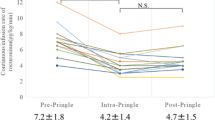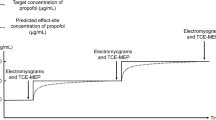Abstract
We investigated the muscular relaxant properties of propofol in a 54 year-old-man with severe tetanus. Four consecutive boluses of propofol 50 mg i.v. were administered. Mean muscular activity recorded on an electromyograph (EMG) decreased from 100 to 10–25 mV within 15s after each bolus. EMG values were restored to prior levels 10 min after the last bolus. Maximum decrease of muscular activity was observed with propofol blood level between 2.90–3.20 μg·ml−1. Neuromuscular function recorded by means of evoked electromyography was not affected by propofol administration.
Similar content being viewed by others
References
Alfery DD, Rauscher LA (1979) Tetanus: a review. Crit Care Med 7:176–181
Borgeat A, Popovic V, Schwander D (1991) Efficiency of a continuous infusion of propofol in a patient with tetanus. Crit Care Med 19:295–297
Kumar A, Lee TL, Adaikan PG, Lau LC Ratnam SS (1989) Effect of propofol on guinea pig tracheal smooth muscle. Anesthesiology 71:A280
Jacque JJ, Gold MI, De Lisser EA, Herrington C (1990) Is propofol a muscle relaxant? Anesth Analg 70:S172
Udwadia FE, Lall A, Udwadia ZF, Sekhar M, Vora A (1987) Tetanus and its complications: intensive care and management experience in 150 Indian patients. Epidemiol Infect 99:675–684
Newman LH, McDonald JC, Wallace PGM, Ledingham I McA (1987) Propofol infusion for sedation in intensive care. Anaesthesia 42:929–937
Sebel PS, Lowdon JD (1989) Propofol: a new intravenous anesthesic. Anesthesiology 71:260–277
Bleck TP (1986) Pharmacology of tetanus. Clin Pharmacol 9:103–120
Mellanby J, Green J (1981) How does tetanus toxin act? Neuroscience 6:281–300
De Grood PMRM, Van Egmond J, Van de Wetering M, Van Beem HB, Booij LHDJ, Crul JF (1985) Lack of effects of emulsified propofol (“disoprivan”) on vecuronium pharmacodynamics — preliminary results in man. Prostgrad Med J 61 [Suppl]:28–30
Author information
Authors and Affiliations
Rights and permissions
About this article
Cite this article
Borgeat, A., Dessibourg, C., Rochani, M. et al. Sedation by propofol in tetanus — is it a muscular relaxant?. Intensive Care Med 17, 427–429 (1991). https://doi.org/10.1007/BF01720683
Received:
Accepted:
Issue Date:
DOI: https://doi.org/10.1007/BF01720683




